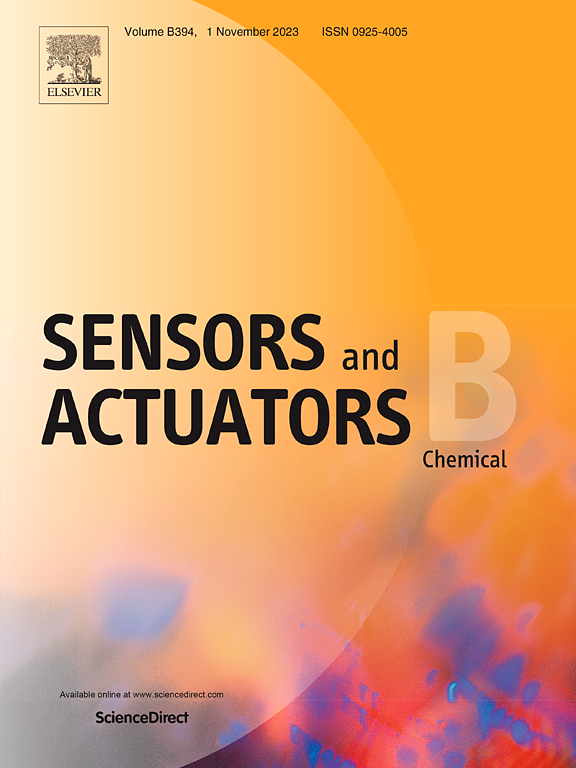一种自加速响应荧光传感器,用于快速和特异性的癌症生物标志物EpCAM检测和体内癌症成像
IF 8
1区 化学
Q1 CHEMISTRY, ANALYTICAL
引用次数: 0
摘要
肿瘤生物标志物的检测和原位荧光成像对于癌症的早期诊断、进展和治疗信息以及预后评估至关重要。上皮细胞粘附分子(Epithelial cell adhesion molecule, EpCAM)是一种基于蛋白质的癌症生物标志物,已被确认为上皮样癌症诊断和治疗的一个有吸引力的靶点。目前用于EpCAM的荧光传感器要么是“永远打开”,要么是仅在活细胞中传感和成像,导致高背景干扰或限制实用性。本研究基于适配体-聚二乙炔纳米脂质体构建了一种简单有效的APN传感器,用于EpCAM的近红外(NIR)荧光检测。EpCAM、适体和阳离子聚二乙炔(PDA)纳米脂质体之间的多重静电和非共价相互作用协同产生了自加速效应,使EpCAM能够在几分钟内以高灵敏度和选择性检测到。我们的APN传感器还可以在靶向癌细胞中实现EpCAM的定量和原位定位。在肿瘤小鼠模型中的生物成像研究进一步证明了APN传感器作为epcam靶向肿瘤持续体内成像的优秀显像剂的能力。进一步利用APN传感器对乳腺癌患者病理切片的癌灶进行描绘,显示出良好的鉴别能力。因此,我们的策略不仅为EpCAM传感和靶向癌症成像建立了一个有吸引力的替代方案,而且还提供了一个适用于设计其他疾病生物标志物传感器的通用传感平台。本文章由计算机程序翻译,如有差异,请以英文原文为准。

A self-accelerated responsive fluorescent sensor for rapid and specific cancer biomarker EpCAM detection and cancer imaging in vivo
The detection and in-situ fluorescence imaging of cancer biomarkers are crucial for early cancer diagnosis, progression and treatment informing as well as prognosis evaluation. Epithelial cell adhesion molecule (EpCAM) is a protein-based cancer biomarker that has been affirmed as an attractive target for epithelioid cancer diagnosis and therapy. Current fluorescence sensors for EpCAM are limited by either being “always on” or sensing and imaging only in living cells, leading to high background interference or restricted practicability. In this study, a simple yet effective APN sensor based on aptamer-conjoined polydiacetylene nanoliposomes was developed for near-infrared (NIR) fluorescence turn-on sensing of EpCAM. Multiple electrostatic and noncovalent interactions among EpCAM, the aptamer and cationic polydiacetylene (PDA) nanoliposomes in the system synergistically produced a self-accelerated effect that enabled detection of EpCAM within few minutes with high sensitivity and selectivity. Our APN sensor could also realize the quantification and in-situ mapping of EpCAM in targeted cancer cells. Bioimaging studies in tumor-bearing mice modes further demonstrated the capability of APN sensor as an excellent imaging agent for sustained EpCAM-targeted cancer imaging in vivo. Additionally, APN sensor was further employed to delineate the cancer lesions in pathological sections from patients with breast cancer, showing favorable differentiating ability. Thus, our strategy not only establishes an appealing alternative for EpCAM sensing and targeted cancer imaging but also provides a universal sensing platform applicable to design sensors for other disease biomarkers.
求助全文
通过发布文献求助,成功后即可免费获取论文全文。
去求助
来源期刊

Sensors and Actuators B: Chemical
工程技术-电化学
CiteScore
14.60
自引率
11.90%
发文量
1776
审稿时长
3.2 months
期刊介绍:
Sensors & Actuators, B: Chemical is an international journal focused on the research and development of chemical transducers. It covers chemical sensors and biosensors, chemical actuators, and analytical microsystems. The journal is interdisciplinary, aiming to publish original works showcasing substantial advancements beyond the current state of the art in these fields, with practical applicability to solving meaningful analytical problems. Review articles are accepted by invitation from an Editor of the journal.
 求助内容:
求助内容: 应助结果提醒方式:
应助结果提醒方式:


